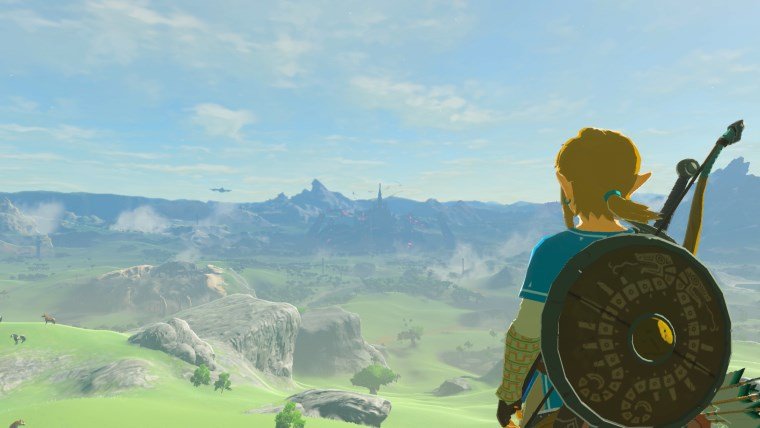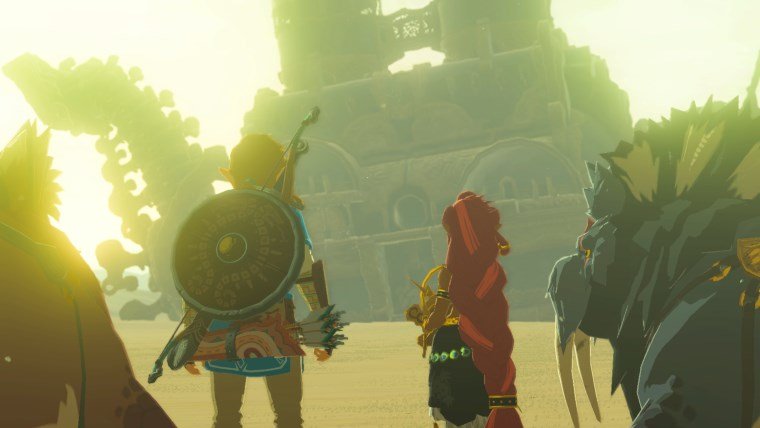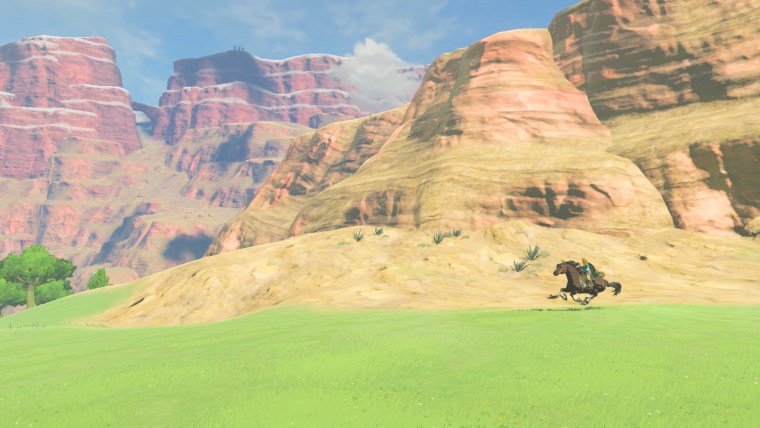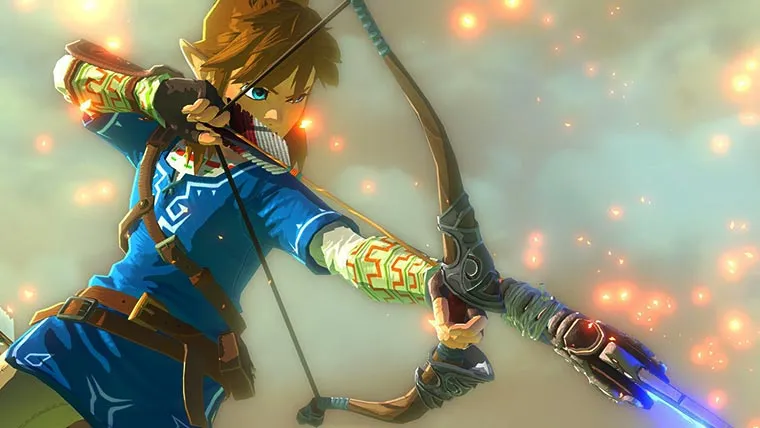A brand new Legend of Zelda game is a big deal in the world of video games. They often mark important moments in the medium, sort of setting delineation points between different eras of gaming. The first did this by showing what a video game could be, offering the feeling of adventure in a simple, 2D space. Ocarina of Time once again revolutionized games by showing how to make a 3D action experience work. It became the standard bearer for 3D titles, and video games would simply not be the same without it. Now Nintendo has once again set the standard with The Legend of Zelda: Breath of the Wild, showing how open-world adventure gaming can really be done.
The Legend of Zelda: Breath of the Wild is unlike any other game in the series. This much has been clear throughout the promotional period, which began on the Wii U and has since transitioned to the Nintendo Switch. The game takes the long running series, throws out a number of its most important conventions, remixes the rest, and adds on an open-world environment. This obviously led to some suspicion about how the game would turn out. Would it still feel like a Zelda game? Would the open-world be boring? These and so many other questions were running through my mind throughout the first couple of hours.

These early moments will be the worst you spend in the game, which is truly saying something, because they’re still quite enjoyable. Breath of the Wild learned from the mistakes of its predecessors and starts players off quickly. There’s no long tutorial sequence here. You wake up, you get a quick rundown of the situation, and you are let loose into the world. It is a limited world though, the totality of Breath of the Wild’s ridiculously massive map isn’t truly open to you until you complete a series of missions. These are designed first to teach you about how the game works, but they serve another purpose: giving you every single tool you’ll need to get anywhere you want.
Breath of the Wild will stun you with the choices that it lays at your feet in just these first few hours
In a radical first for The Legend of Zelda series, by the time you complete the opening tutorial area you will have all the major tools necessary to complete the game. Without giving too much away, as discovering things for yourself is a big part of what makes Breath of the Wild so great, the tools include bombs and a number of ways to manipulate other objects. The four tools available are so versatile that the rest of the game is built around discovering new ways to use them, both separately and together. Even dozens of hours into the game you’ll find new ways to do accomplish complex tasks, and it’s a glorious “aha!” moment almost every single time.
Once you finish this opening section and have all of your abilities you can go wherever you want and do whatever you want. It’s a jarring feeling, especially if you’ve been a fan of the Zelda formula that was established so long ago. You are, of course, given a general direction that will serve you best, if you want to continue the quite engaging and mature story. But it’s all up to you, and even if you’ve played open-world games before, Breath of the Wild will stun you with the choices that it lays at your feet in just these first few hours.
This is also the source of Breath of the Wild’s high difficulty challenge. The game is not punishingly difficult, and it never becomes frustrating. Instead it offers a real challenge, and one that is totally within your control. Enemies do not necessarily scale based on anything, though the further you get from the starting area, the more higher level enemies you’ll come across. This means you can find a safe place, explore it thoroughly while building up your character and skills, then move on. You can also rush through the main quest, as completing parts of it give you very powerful magical abilities. These can be turned off to keep the challenge going, or you can always charge ahead into unfamiliar territory and count on your skills to carry you. I’ve found myself in areas that felt like too much for me, but through clever use of my available abilities and items I was able to get through, and the feeling of satisfaction was all the greater for it.
This is The Legend of Zelda: Breath of the Wild
Soon after leaving the starting area and getting your bearings you will branch out, exploring the map with tentative steps at first, but quickly establishing your own formula that will repeat throughout your time with Breath of the Wild. This usually involves some form of climbing to a high point, scoping out the surrounding area, deciding on a few places to go, and then heading that way with the hope that you won’t get distracted by some cool area, item, or enemy, delaying your efforts to thwart Ganon for another couple of hours.
This is a joke, of course, as this is actually another of Zelda: Breath of the Wild’s biggest strengths. So many open-world games feel so empty and lifeless. Even the really good ones have some problems causing them to feel like you’re just getting from point A to point B, without much to do in between. The Legend of Zelda: Breath of the Wild is filled to the brim with surprises, excitement, and adventure, no matter where you are. Navigating the map is actually the most fun part of the game, as you explore every nook and cranny trying to discover new things.
You’ll find these new things almost everywhere too. Even while I was trying to finish up the main quest I would stumble across some interesting area of the map, or run across a new mission that looked cool, causing me to change focus over and over again. But what really separates Breath of the Wild from most other open-world games is the content of these missions and objectives that you stumble across. They aren’t simple, “go here, kill that” sorts of things, instead many are interesting, deep experiences that are fun to play in their own right.

I’ll give an example. While moving toward one of the game’s main objectives, I spot some tall structures that look different than anything else in the game. On top of one I see a small shack, so I head to the mountain near it and paraglide down to one of the smaller structures. I then make my way to the top, which requires some of the stamina boosting meals I had cooked at my last stop off at a stable. Once on top I run across a character who is playing music. Listening to his song queues me into something I’d spotted down below, but I’ll have to wait a couple of days for a specific event to happen, while performing the task he describes in the song. So, I climb back down and set up camp, using my fire enchanted spear to light up stacks of wood, allowing me to rest until the next day, eventually getting to the specific time event I need and completing the mission.
This is just one random mission that I stumbled across while trying to do the main quest, and it’s memorable enough that I could describe it to anyone else playing the game. And it was so far off the beaten path that I doubt most players will ever even come across it, creating unique experiences among the community, allowing for endless discussion about what players did and did not encounter.
Helping these missions feel more alive and realistic is that Breath of the Wild’s objective list works so well at keeping everything in check, while also not giving too much away. Your objective marker will show up on the map, but it’s not a pointer to the end of the quest, unless it was something obvious already. Instead it will get you where you need to be, and let you work out the rest. This is a great middle ground between being totally lost as to what needs to be done, and simply feeling like you are checking off boxes on a list.
Even more than this though, this world and these missions wouldn’t work if Breath of the Wild’s world wasn’t enjoyable to explore. It is, and to a degree that I’ve never experienced in another video game before. In previous Zelda games the subtitle referred to some object within the game. Some important item that was the focal point of the experience that players were about to have. Breath of the Wild is instead describing the experience as given by the environment itself.

It’s not hyperbole to say that I could spend hours in Breath of the Wild simply sitting and listening to the things going on around me. The soundscape is gorgeous, with grass and leaves rustling in the wind along with soft, scenic music. Breath of the Wild’s music isn’t as in your face as other games in the series, which means you likely won’t catch yourself humming its tunes years down the road, but you will appreciate its music for what it does, which is set the mood perfectly. Combining this with weather, animal, and general environment sounds creates a true feeling of presence within this world. The only noticeable flaw in the audio department are somewhat subpar English voice actors. The voicework doesn’t run throughout the game, only appearing in small chunks, but overall it felt not up to the quality of the rest of the game’s presentation.
The visuals are truly stunning as well, as anyone can see from the many videos available. The art style and design seen in Breath of the Wild is amazing in many ways, with the world coming to life around you as the grass moves with the wind and enemies animate in glorious cartoony fashion. This is running on the Switch though, which means the power isn’t up to more modern standards, and Breath of the Wild does suffer a bit here. In handheld mode the game seems to run a bit better, holding a fairly solid framerate. Once docked and increased to the higher TV resolution, the game can start to struggle when more effects come into play. This hasn’t directly impacted gameplay though, so it can largely be ignored thanks to the other elements of the game compensating for the trouble.
If I’m spending a lot of time focusing on the world itself in this review, it’s because it’s the biggest and best portion of The Legend of Zelda: Breath of the Wild. Unlike previous games which had overworlds whose main purpose was getting you into the next big dungeon, Breath of the Wild makes its overworld the focus and puts the dungeons into the secondary slot. And even when it does finally present you with dungeons, they are still radically different than the ones you’ve become accustomed to, as you might have expected after all of the other big changes.

Breath of the Wild’s four main dungeons are in some ways simpler than what we’ve seen before, and more complex in others. The overall feel is that they’re a bit easier and smaller, and the fact that they aren’t dark, underground caverns almost stretches the definition of the term “dungeon”. But the feeling of classic Zelda dungeons is still there, even if they don’t offer exactly the same level of intricate puzzle solving. Where they’re more complex is in the fact that you control aspects of the dungeon, altering the landscape in different ways. This sometimes leads to some true brain bending moments, that even longtime Zelda fans will find difficult. The end bosses are serviceable, but likely won’t go down as series greats though.
The Legend of Zelda: Breath of the Wild is one of the best games ever made.
If four dungeons sounds like too few, Breath of the Wild has you covered with its 100+ Shrines. These are essentially mini or even micro dungeons, consisting of a room or two and a couple of puzzles, usually with a theme. Some are ridiculously easy, while others will present a challenge, especially in the optional extra objective which usually yields some weapon or item. The great thing about this setup is that you spread out the experience of a Zelda dungeon, keeping players engaged with puzzles and the abilities they have to use to solve them, without bogging them down with a full blown series of challenges. And there are so many of them to discover, with each giving players a sense of accomplishment, as well as unlocking another fast travel point on your map.
And yet, with all of this, there’s still more that Breath of the Wild does differently than any of its predecessors, and almost every change is for the better. You can now swap gear, with each offering unique attributes for defense and other factors. Your weapons will degrade with use, requiring you to think about encounters in entirely new ways and branch out from your comfort zone of a shield and sword. You have to worry about stamina, which can be increased by completing multiple Shrines, but only if you are willing to forgo an additional heart container.
And climbing…there’s not enough words to describe how important and integral to Breath of the Wild’s gameplay it is that Link is able to climb practically any surface. It shifts the entire way you look at the world, making it feel more real and alive thanks to the fact that you can look at a mountain and say to yourself “I want to go to the top” and actually know that you can do it.

The only thing that remains relatively unchanged is combat itself. You’ll still be swinging a sword and blocking hits with a shield, unless you’re using a two-handed weapon. You can jump to do more damage, or dodge out of the way. Successful and well-timed dodges will enact a new feature where you can mash the attack button for a ton of quick, successive strikes. It gives combat a bit of extra timing and strategy. Outside of direct fights though, you do have lots of additional options, including stealth and creative methods of taking out foes using your four key abilities.
The Verdict
The simple fact is that The Legend of Zelda: Breath of the Wild is one of the best games ever made. It marks a turning point for the medium that will be learned from for some time. It is a system seller in every sense of the word, and if you don’t already have a way to play it, you owe it to yourself to find one. Few games make you feel so many emotions and so strongly. You will be excited, scared, curious, adventurous, happy, sad, and everything in between. You will put in dozens of hours and still feel like you’ve only scratched the surface. The Legend of Zelda: Breath of the Wild is a triumph of game design and it will be remembered as a true milestone for the entire art form.











Published: Mar 2, 2017 04:59 am